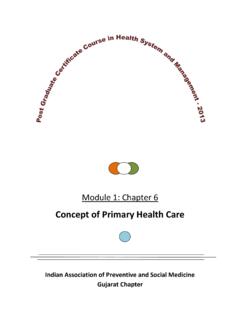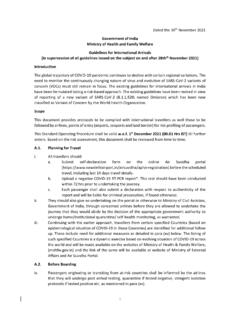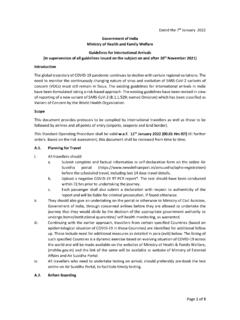Transcription of Indian Public Health Standards (IPHS) For Primary Health ...
1 1 Draft Indian Public Health Standards (IPHS) For Primary Health Centres GUIDELINES (March 2006) Directorate General of Health Services ministry of Health & family welfare government of india 2 Contents: Executive Summary 3 1. Introduction 5 2. Objectives of IPHS for PHC 7 3. Minimum Requirements at the PHC 7 4. Essential Infrastructure 15 PHC Building 15 Equipment and Furniture 20 5.
2 Manpower 20 6. Drugs 21 7. Transport Facilities 21 8. Laundry and Dietary Facilities for indoor patients 21 9. Waste Management at PHC level 22 10. Quality Assurance in Service Delivery 22 11. Monitoring 22 12. Accountability 23 Annexures: Annexure1: Current Immunization Schedule 24 Annexure2 & 2A: Layout of PHC 25 & 26 Annexure3: List of Equipment and Furniture 27 Annexure4: Drug List 33 Annexure5: Universal Precautions 46 Annexure6.
3 Check List 48 Annexure7: Job Responsibilities of Medical Officer and other staff 52 Annexure8: Charter of Patients Rights 77 Annexure9: Performa for Facility Survey Format for PHC 79 List of Abbreviations 89 References 90 3 Executive Summary Primary Health Centres are the cornerstone of rural Health services- a first port of call to a qualified doctor of the Public sector in rural areas for the sick and those who directly report or referred from Sub-centres for curative, preventive and promotive Health care. A typical Primary Health Centre covers a population of 20,000 in hilly, tribal, or difficult areas and 30,000 populations in plain areas with 4-6 indoor/observation beds.
4 It acts as a referral unit for 6 sub-centres and refer out cases to CHC (30 bedded hospital) and higher order Public hospitals located at sub-district and district level. Standards are the main driver for continuous improvements in quality. The performance of Primary Health Centres can be assessed against the set Standards . In order to provide optimal level of quality Health care, a set of Standards are being recommended for Primary Health Centre to be called Indian Public Health Standards (IPHS) for PHCs. The launching of National Rural Health Mission (NRHM) has provided this opportunity. The Standards prescribed in this document are for a PHC covering 20,000 to 30,000 populations with 6 beds. Setting Standards is a dynamic process. Currently the IPHS for Primary Health Centres has been prepared keeping in view the resources available with respect to functional requirement for Primary Health Centre with minimum Standards such as building manpower, instruments, and equipments, drugs and other facilities etc.
5 The overall objective of IPHS for PHC is to provide Health care that is quality oriented and sensitive to the needs of the community. These Standards would help monitor and improve the functioning of the PHCs. 4 Service Delivery: All Assured Services as envisaged in the PHC should be available, which includes routine, preventive, promotive, curative and emergency care in addition to all the national Health programmes. Appropriate guidelines for each National Programme for management of routine and emergency cases are being provided to the PHC. All the support services to fulfil the above objectives will be strengthened at the PHC level. Minimum Requirement for Delivery of the Above-mentioned Services: The following requirements are being projected based on the basis of 40 patients per doctor per day, the expected number of beneficiaries for maternal and child Health care and family planning and about 60% utilization of the available indoor/observation beds (6 beds).
6 It would be a dynamic process in the sense that if the utilization goes up, the Standards would be further upgraded. As regards, manpower, one more Medical Officer (may be from AYUSH or a lady doctor) and two more staff nurses are added to the existing total staff strength of 15 in the PHC to make it 24x7 services delivery centre. Facilities The document includes a suggested layout of PHC indicating the space for the building and other infrastructure facilities. A list of equipment, furniture and drugs needed for providing the assured services at the PHC has been incorporated in the document. A Charter of Patients Rights for appropriate information to the beneficiaries, grievance redressal and constitution of Rogi Kalyan Samiti/ Primary Health Centre Management Committee for better management and improvement of PHC services with involvement of PRI has also been made as a part of the Indian Public Health Standards .
7 The monitoring process and quality assurance mechanism is also included. 5 Indian Public Health Standards for Primary Health Centres 1. Introduction: The concept of Primary Health Centre (PHC) is not new to india . The Bhore Committee in 1946 gave the concept of a PHC as a basic Health unit to provide as close to the people as possible, an integrated curative and preventive Health care to the rural population with emphasis on preventive and promotive aspects of Health care. The Health planners in india have visualized the PHC and its Sub-Centres (SCs) as the proper infrastructure to provide Health services to the rural population. The Central Council of Health at its first meeting held in January 1953 had recommended the establishment of PHCs in community development blocks to provide comprehensive Health care to the rural population.
8 These centres were functioning as peripheral Health service institutions with little or no community involvement. Increasingly, these centres came under criticism, as they were not able to provide adequate Health coverage, partly, because they were poorly staffed and equipped and lacked basic amenities. The 6th Five year Plan (1983-88) proposed reorganization of PHCs on the basis of one PHC for every 30,000 rural population in the plains and one PHC for every 20,000 population in hilly, tribal and backward areas for more effective coverage. Since then, 23,109 PHCs have been established in the country (as of September 2004). PHCs are the cornerstone of rural Health services- a first port of call to a qualified doctor of the Public sector in rural areas for the sick and those who directly report or referred from Sub-centres for curative, preventive and promotive Health care.
9 It acts as a referral unit for 6 sub-centres and refer out cases to 6 Community Health Centres (CHCs-30 bedded hospital) and higher order Public hospitals at sub-district and district hospitals. It has 4-6 indoor beds for patients. PHCs are not spared from issues such as the inability to perform up to the expectation due to (i) non-availability of doctors at PHCs; (ii) even if posted, doctors do not stay at the PHC HQ; (iii) inadequate physical infrastructure and facilities; (iv) insufficient quantities of drugs; (v) lack of accountability to the Public and lack of community participation; (vi) lack of set Standards for monitoring quality care etc. Standards are a means of describing the level of quality that Health care organizations are expected to meet or aspire to.
10 Key aim of these Standards is to underpin the delivery of quality services which are fair and responsive to client s needs, which should be provided equitably and which deliver improvements in the Health and wellbeing of the population. Standards are the main driver for continuous improvements in quality. The performance of Health care delivery organizations can be assessed against the set Standards . The National Rural Health Mission (NRHM) has provided the opportunity to set Indian Public Health Standards (IPHS) for Health Centres functioning in rural areas. There are Standards prescribed for a 30 bedded hospital by Bureau of Indian Standards (BIS). Recently, under NRHM, Indian Public Health Standards have been framed for Community Health Centre as the BIS is considered as very resource-intensive at the present scenario.




